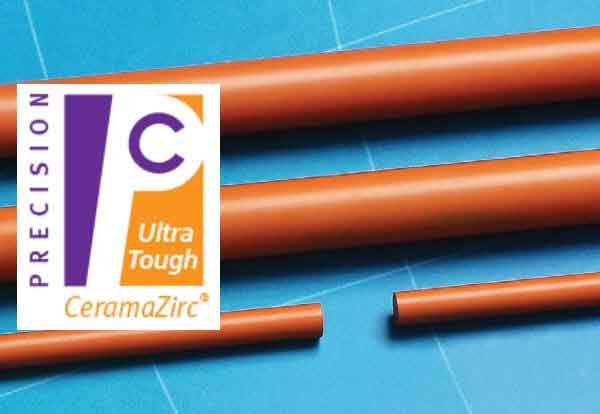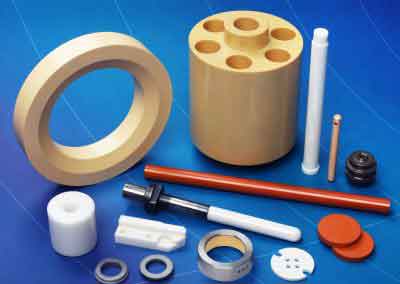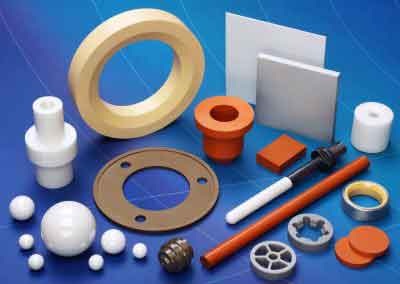Zirconia Overview
Unlike traditional ceramics that tend to be hard and brittle, Zirconia offers high strength, wear resistance, and flexibility far beyond those of most other technical ceramics. Zirconia is a very strong technical ceramic with excellent properties in hardness, fracture toughness, and corrosion resistance; all without the most common property of ceramics – high brittleness.
There are several grades of Zirconia available, the most common of which are Yttria Partially Stabilized Zirconia (Y-PSZ) and Magnesia Partially Stabilized Zirconia (Mg-PSZ). Both of these materials offer excellent properties, however, the operating environment and part geometry will dictate which grade may be suitable for specific applications (more on this below). Its unique resistance to crack propagation and high thermal expansion make it an excellent material for joining ceramics with metals like steel. Due to Zirconia’s unique properties it is sometimes referred to as the “ceramic steel”.
CeramaZirc Ultra Tough
CeramaZirc Ultra Tough is an advanced zirconia-based ceramic composite material based on partially stabilized zirconia and alumina platelets and is the latest and toughest composite to be introduced by China Ceramic Parts.

Zirconia Properties
General Properties
Composition
Color
Unit
CeramaZirc
CeramaZirc Plus
CeramaZirc Nano-HIP
Mechanical Properties
Density
Youngs Modulus
Fracture Toughness
Poissons Ratio
Compressive Strength
Flexural Strength
Hardness (Vickers 500g)
Unit
CeramaZirc
CeramaZirc Plus
CeramaZirc Nano-HIP
Thermal Properties
Max Use Temp
Coefficient of Expansion
Thermal Conductivity, 25°C
Thermal Shock Resistance ΔT
Unit
CeramaZirc
CeramaZirc Plus
CeramaZirc Nano-HIP
** Coefficient of Thermal Expansion (CTE) describes how the size of an object changes with a change in temperature.
Electrical Properties
Dielectric Strength 6.35mm
Dielectric Constant 25° C
Volume Resistivity @ 25°C
Volume Resistivity @ 300°C
Volume Resistivity @ 500°C
Volume Resistivity @ 700°C
Unit
CeramaZirc
CeramaZirc Plus
CeramaZirc Nano-HIP
Related Materials

CeramaZirc Ultra Tough
CeramaZirc, dubbed 'ceramic steel', is an advanced zirconia-based ceramic composite material -- it's the latest and toughest material to be introduced by China Ceramic Parts.
Available Grades of Zirconia
Yttria Partially Stabilized Zirconia (Y-PSZ)
Yttria Partially Stabilized Zirconia (Y-PSZ) is doped with Yttrium oxide (Y2O3) as a stabilizing agent which stresses the internal grain structure and makes the material stronger by changing it from a monoclinic to tetragonal phase. It is a fine grain material that has one of highest flexural strength among all ceramic materials. It has very high impact and wear resistance while offering a low thermal conductivity, often making it a suitable material to replace metals.The addition of Yttrium oxide (Yttria) enables the material to undergo transformation toughening which is responsible for the high toughness. As the material is stressed, it becomes more energetically favorable for the crystal structure to revert back to transforms from tetragonal to monoclinic phase, resulting in a highly localized volume increase of 3% – 5%. This increase in volume puts crack under compression which reduces its ability to grow and propagate into more cracks. This characteristic accounts for the material’s low susceptibility to stress fatigue and high flexural strength.
While Y-PSZ is excellent for demanding mechanical applications, it may not be suitable for very high temperature applications because it suffers from grain boundary sliding; this occurs when prolonged exposure to heat causes the material to transform form the strong tetragonal phase to the weaker monoclinic phase. Similarly, it may not be suitable for warm and moist conditions since its properties deteriorate when it is exposed to water vapor. YSZ is therefore best suited when it is operating in dry and moderate temperature conditions. For more information on hydrothermal aging of Zirconia please contact us.
Magnesia Partially Stabilized Zirconia (MSZ)
Doping of Zirconia with Magnesium oxide (MgO) also leads to a stressed internal matrix, however, this structure is cubic. M-PSZ has better temperature and moisture resistant properties because it does not suffer from phase migration. M-PSZ maintains its strength even in moist high temperature environments where YSZ mechanical properties begin to deteriorate.
Zirconia Manufacturing
Zirconia can be machined in green, biscuit, or fully dense states. While in the green or biscuit form it can be machined relatively easily into complex geometries. However, the sintering process that is required to fully densify the material causes the Zirconia body to shrink approximately 20%. This shrinkage means that it is impossible to hold very tight tolerances when machining Zirconia pre-sintering.
In order to achieve very tight tolerances, fully sintered material must be machined/ground with diamond tools. In this process a very precise diamond coated tool/wheel is used to abrade away the material until the desired form is created. Due to the inherit toughness and hardness of the material, this can be a time consuming and costly process.
China Ceramic Parts is your Zirconia machining specialist for your technical ceramic prototyping & manufacturing needs; we are always happy to use our many years of advanced ceramics experience to provide advice on materials, design, and application. If you would like to buy Zirconia plates, rods, tubes or custom machined components, please contact us and one of our experts will be happy to assist you.
Frequently Asked Questions
- What is Zirconia ceramic?
Zirconia is a very strong technical ceramic with excellent properties in hardness, fracture toughness, and corrosion resistance; all without the most common property of ceramics – high brittleness. Unlike traditional ceramics that tend to be hard and brittle, Zirconia offers high strength, wear resistance, and flexibility far beyond those of most other technical ceramics.
There are several grades of Zirconia available, the most common of which are Yttria Partially Stabilized Zirconia (Y-PSZ) and Magnesia Partially Stabilized Zirconia (Mg-PSZ). Both of these materials offer excellent properties, however, the operating environment and part geometry will dictate which grade may be suitable for specific applications (more on this below). Its unique resistance to crack propagation and high thermal expansion make it an excellent material for joining ceramics with metals like steel. Due to Zirconia’s unique properties it is sometimes referred to as the “ceramic steel”. - What can Zirconia ceramic be used for?
- Wire forming/drawing dies
- Insulating rings in thermal processes
- Precision shafts and axles in high wear environments
- Furnace process tubes
- Wear resistance pads
- Thermocouple protection tubes
- Sandblasting nozzles
- Refractory material
- Extrusion dies
- Bushings and caps
- Kiln furniture crucible
- Fiber optic ferrules and sleeves
- Knives and blades
- Fuel cell parts
- Bearings & rollers
- Welding nozzles & pins
- Laser parts
- Gas igniters
- Electric insulator
- Ceramic guiders
- Oxygen sensors
- Medical and surgical component
- Mechanical seals
- Pumps, pistons, and liners
- What's the difference between Yttria vs. Magnesia Zirconia?
While Y-PSZ is excellent for demanding mechanical applications, it may not be suitable for very high temperature applications because it suffers from grain boundary sliding; this occurs when prolonged exposure to heat causes the material to transform form the strong tetragonal phase to the weaker monoclinic phase. Similarly, it may not be suitable for warm and moist conditions since its properties deteriorate when it is exposed to water vapor. YSZ is therefore best suited when it is operating in dry and moderate temperature conditions. For more information on hydrothermal aging of Zirconia please contact us.
M-PSZ has better temperature and moisture resistant properties because it does not suffer from phase migration. M-PSZ maintains its strength even in moist high temperature environments where YSZ mechanical properties begin to deteriorate. - What are the properties of Zirconia?
The following are some general properties of Zirconia ceramic. For a full list and comparison of Zirconia properties, see our Zirconia properties comparison table.
- High density – up to 6.1 g/cm^3
- High flexural strength and hardness
- Excellent fracture toughness – impact resistant
- High maximum use temperature
- Wear resistant
- Good frictional behavior
- Electrical insulator
- Low thermal conductivity – aprox. 10% of Alumina
- Corrosion resistance in acids and alkalis
- Modulus of elasticity similar to steel
- Coefficient of thermal expansion similar to iron



